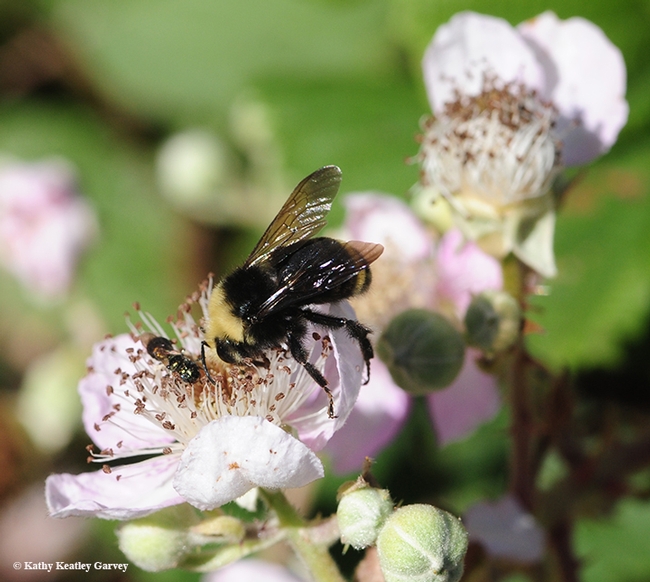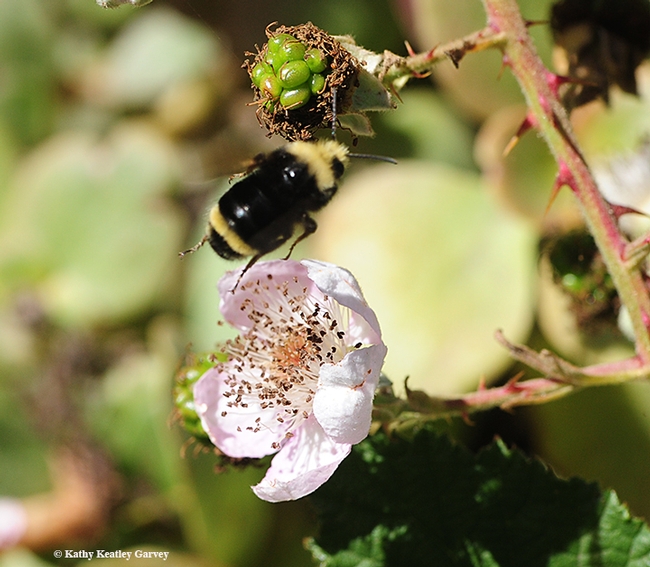
Posts Tagged: blackberry
Organic herbicide effects on Himalayan blackberry: only short-term control, but also avoided damage to willow
Valerie Eviner is a Professor of Ecosystem Management and Restoration in the Department of Plant...
Black Friday: Bumble Bees and Blackberries
"Black Friday" means different things to each of us, but when I think of "Black Friday," I think of...

A bumble bee, Bombus vosnesenskii, nectaring on a blackberry blossom in Berkeley. (Photo by Kathy Keatley Garvey)

Taking flight, the yellow-faced bumble bee, Bombus vosnesenskii, seeks another blackberry blossom in Berkeley. (Photo by Kathy Keatley Garvey)
Broad mites in Blackberry
A sample of broad mites from primocane blackberry was dropped off at my office a couple of weeks ago. The mites are quite small (much smaller than twospotted spider mite), were found colonizing the younger emerging leaves of the plant and apparently giving the leaves a rumpled, curled appearance something similar to what one might see from very light Round Up damage (Photo 1 below).
As per the UC IPM guidelines, populations of broad mite tend to be most severe in warm, humid conditions such as those found in greenhouses. Which is a pretty spot on description of the weather we have had for like the last 10 weeks.
Also as per the UC IPM guidelines, the broad mites here are yellowish in color, and some (the females) have a white stripe clearly visible on the back. The eggs have distinct dimples on them (Photo 2 below).
The association with primocane blackberry is of interest. Looking back through my files, I see a communication concerning broad mites on the same in the Southeastern US, and I've been getting some calls and texts here in the area again regarding broad mites on local primocane blackberries, both public and proprietary.

Primocane blackberry leaves affected by broad mite. Note curling and slightly rumpled appearance.

Broad mite on citrus. Note the distinct dimples on the eggs in the upper right hand corner of the photo. Photo UC IPM.
Heat Induced Pollination Problems in Blackberry
Interesting case documented in the pictures below of PrimeArk 45 blackberry in which the fruit did not pollinate very well. The issue is limited to one area of the field, where the grower suspects it wasn't quite moist enough during the hot spell of two weeks ago.
The problem does seem to be limited to a certain age of fruit in that area of the field, and if one recalls two weeks ago during this hot spell we didn't have much customary cooling at night.
This makes sense, since as readers know, high temperatures reduce the amount of viable pollen and consequently the success rate of germination on the pistil. It is good to know as a field diagnostician that the peripheral pistils on the flower become receptive first, and as a rule not all pistils are receptive at the same time. This goes some length to explaining the unevenness of pollination and subsequent lack of druplet formation.

Blackberry fruit, some properly pollinated, others not. Note the differences in age of fruit (oldest fruit was harvested - note remaining pedicels) and number of formed drupelets, a strong indication that a single event is responsible for this insufficiency of pollination.

Blackberries not properly pollinated - heat and possibly an insufficiency of water is at cause for this failure to make.
Post harvest Powerpoint for Raspberries and Blackberries
Excellent Powerpoint given by UC Davis' Marita Cantwell at Oleg Daugovish's caneberry meeting this past April. Probably the best you are going to find anywhere concerning post harvest handling of these delicate fruits:
http://ceventura.ucanr.edu/files/188522.pdf
